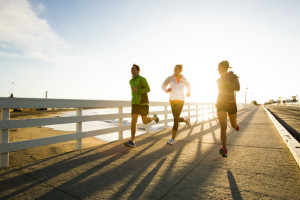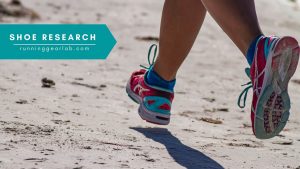Best Running Socks 2025: Stop the Blister Misery (From Someone Who’s Been There)
There’s nothing quite like hitting mile 18 of your long run and feeling that hot spot develop into a full-blown blister that’ll haunt you for the next week. Been there? Yeah, me too.
Here’s the thing about running socks that took me way too long to figure out: the $4 cotton socks from Target are basically setting your feet up for failure I know, I know—spending $15-20 on a single pair of socks feels ridiculous. But after testing over 30 pairs during marathon training (and yes, getting some spectacular blisters in the process), I’ve learned that good running socks are the cheapest performance upgrade you can make.
**Last Updated:** October 2025 | **Blisters Endured During Testing:** More than we’d like to admit
Top 10 Running Socks to Prevent Blisters Chart
| Socks | Main Features | Our Score | |
|---|---|---|---|
Top pick | Balega Blister Resist No Show Socks
| ||
Winter | Darn Tough Darn Tough Hiker 1/4
| ||
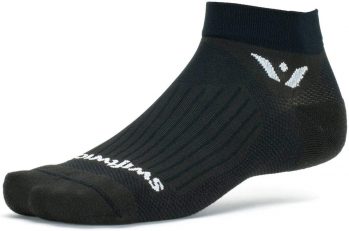 | Swiftwick- ASPIRE ONE Running Sock
| ||
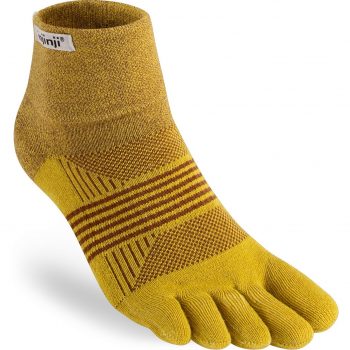 | Injinji Men’s Trail Midweight Mini Crew Toesocks
| ||
 | Wrightsock Anti-Blister Double Layer Running
| ||
 | Feetures Elite Max Cushion Quarter Sock
| ||
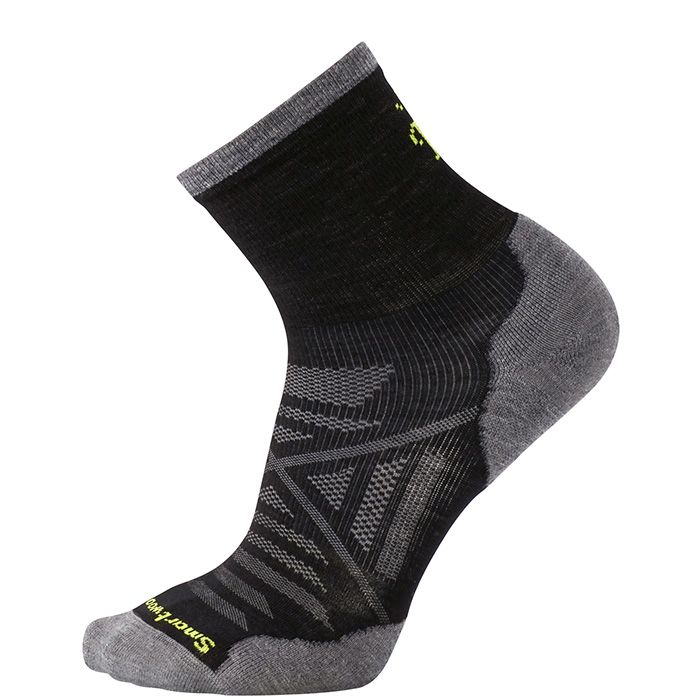 | Smartwool PhD Run Cold Weather Mid Crew
| ||
 | CEP unisex-adult Ultralight Short Socks
| ||
 | Rockay Accelerate Anti-Blister Running Socks
| ||
 | Vitalsox Italy Compression Sock
|
Anti Blister Running Socks In Depth Reviews
1. Balega Blister Resist No Show – Best Overall Anti-Blister Sock ⭐⭐⭐⭐⭐
There’s a reason every running store employee recommends these they just work. After for a marathons in Balegas, I’ve yet to get a single blister wearing them. That’s not marketing hype that’s my actual experience.
What Makes Them Special:
- Blister Resist technology adds extra cushioning in high-friction zones (heel, toes)
- Deep heel pocket keeps the sock locked in place—no slipping = no friction
- Seamless toe box means zero rubbing on that sensitive area up front
- Mohair + Drynamix® blend wicks moisture like magic—feet stay dry even in summer heat
- Medium cushioning hits the sweet spot—not too thick, not too thin
- Reinforced high-wear areas in heel and toe last 300-400 miles easily
- No-show height works perfectly with road running shoes
Real Talk – The Downsides:
- •$15/pair isn’t cheap (but still cheaper than treating blisters)
- Only available in no-show height or crew (no quarter options in this)
- •Sizing runs a bit small—go up if you’re between sizes
- Hand wash recommended for longevity (I throw mine in the machine anyway and they’re fine)
- Slightly thicker than standard Hidden Comfort (might feel snug in narrow shoes)
2. Darn Tough Vertex Quarter – Best for Winter Running & Trail ⭐⭐⭐⭐⭐
When it’s 25°F and you’ve got a morning run scheduled, you need socks that’ll keep your feet warm without turning them into sweat factories. I live wear the winters are cold and Darn Tough Vertex is the merino wool sock that actually lives up to the hype—plus they have a lifetime warranty (seriously).
What Makes Them Special:
- Merino wool magic warmth in winter, cool in summer, never stinky
- Quarter height protects ankles on trails and from cold wind
- True Seamless construction means zero irritation anywhere
- Lifetime warranty – if they wear out, Darn Tough replaces them free
- Naturally anti-microbial you can wear them multiple times between washes (don’t judge)
- The performance fit stays put without slipping
Real Talk – The Downsides:
- •$23/pair is the most expensive on this list
- Takes 2-3 washes to soften up (feel stiff initially)
- Warmer than needed for summer running in hot climates
- Thicker profile may not fit snug racing shoes
- Quarter height not everyone’s preference
3. Swiftwick Aspire Zero – Best for Racing & Speed Work ⭐⭐⭐⭐½
When you’re chasing a PR, every ounce matters. The Aspire Zero is Swiftwick’s lightest sock. Basically a second skin that breathes incredibly well and disappears on your feet.
What Makes Them Special:
- Ultra-lightweightconstruction—you genuinely forget you’re wearing socks
- Compression throughout provides support without squeeze
- Olefin fibers are hydrophobic (literally repel water—feet stay drier longer)
- No-blister guarantee from Swiftwick (they stand behind it)
- Seamless toe and Y-shaped heel to eliminate friction points
- Quick-drying after washing they are ready to go in hours
Real Talk – The Downsides:
- Minimal cushioning isn’t for everyone (zero padding underfoot)
- Tighter fit takes getting used to as they feel like compression socks at first
- Not ideal for runners who need arch support from socks
- Durability suffers slightly due to thin construction (250-300 miles typical)
- $16/pair for minimal material feels premium
4. Injinji Run Lightweight No-Show – Best Toe Blister Prevention ⭐⭐⭐⭐½
Okay, I get it toe socks look weird. I resisted for years. Then I got a bad blister from some new shoes and when returning them the clerk recommend i try these toe socks . Injinji toe socks eliminate toe-on-toe friction entirely, they are great.
What Makes Them Special:
- Individual toe sleeves that completely prevent toes from rubbing together
- Better toe splay allows natural foot mechanics (feels more stable)
- Moisture management between each toe (game-changer in the humidity)
- Arch support band provides gentle compression
- Mesh top panel breathes exceptionally well
- Blister-free toes guaranteed—seriously, it’s impossible with these
Real Talk – The Downsides:
- Getting them on takes 2-3x longer (threading each toe is tedious)
- Weird feeling first few runs
- Not everyone wants to look like they’re wearing gloves on their feet
- Need to carefully match toe length to sock size
- Slightly expensive at $15/pair
Best Running Socks to Prevent Blisters Buying Guide
Let me save you some pain—literally. Here’s everything I learned the hard way about keeping your feet blister-free during marathon training.
Season
Your sock needs are different in the summer than they are in the winter. The best running socks for winter will use thick material (but not too thick) to keep your feet warm. The best running socks for summer are light and breathable.
Socks with merino wool work in all seasons including spring and fall. Most brands offer a winter thick version and a lighter summer version. For the small extra investment, it’s worth having the choice.
- **Quick tips:**
- Summer: Look for mesh panels and lightweight synthetic blends
- Winter: Quarter or crew height adds ankle warmth
- Year-round: Merino wool naturally regulates temperature
Blister Prevention
Anything that can cause friction will create blisters. This mostly affects runners going beyond roughly 10 miles. If you are considering marathon distance or ultra marathons, blister prevention is critical.
Make sure the size of the sock is tight on your foot. You should look for a seamless sock, as the seam can rub against your toes. The height of the sock should be above your shoe and not able to fall down.
- **Key features to prioritize:**
- Seamless toe construction (eliminates #1 blister hotspot)
- Deep heel pocket (prevents sock slippage)
- Snug arch compression (keeps sock in place)
- No bunching or excess fabric anywhere
Odor
Don’t forget smelly feet. While it may seem like a nice-to-have, bacteria is the culprit of stink. If you get broken skin while running in dirty socks, that’s a cause for infection (not good). Moisture-wicking fabrics will keep your feet dry but can also absorb odor. If your feet are very smelly wash them! Socks aren’t going to solve that problem.
- **Odor-fighting features:**
- Merino wool is naturally anti-microbial (can wear 2-3 times between washes)
- Silver-ion treatments prevent bacteria buildup
- Synthetic socks need washing after every run
Material
Choose moisture-wicking and natural fibers like merino wool over cheap materials like cotton. Nylon, polyester, and spandex are often added comfort in a synthetic/natural blend.
- **Why cotton is the enemy:**
- •Absorbs and holds moisture (creates blister conditions)
- Takes forever to dry once wet
- Softens skin making it vulnerable to friction
- Zero performance benefits for running
Cushion
Thick socks can be more comfortable and warmer, but in hot weather thin socks are your friend. If you are blister prone in a specific area, extra cushioning can prevent friction in that area.
Cushioning guide:
- **Light:** Best for racing, speed work, hot weather (e.g., Swiftwick Aspire)
- *Medium:** Versatile for daily training (e.g., Balega Blister Resist)
- **Max:** Long runs, ultra marathons, maximum protection (e.g., Feetures Elite Max)

What is the best length of running a sock to prevent blisters?
No-show, quarter, crew, or knee-high?
You will want to make sure your sock height to be higher than your shoes to prevent your skin from rubbing on the shoe but otherwise, it is your preference what height you would like to run in. No-show socks seem to be a favorite of most runners. First, you need to make sure to find a no-show sock that has a lip at the back to prevent the sock from slipping down, therefore, preventing your running shoes from rubbing against your skin. If you are trail running with shorts on a higher sock would be beneficial to protect your ankles against branches and poison ivy if any is around.
Marathon runners have great things to say about compression socks, which help regulate the circulation in the legs and make it easier to go for longer runs. Recovery time after a long run is much quicker with a compression sock.
Toe socks aren’t for everyone, but we recommend that you give them a go if you are prone to blisters in between the toes. They offer great benefits and help evenly spread out your toes to offer you more stability and comfort (yes, comfort!). If you run, you might notice a big difference if you are wearing a pair of toe socks.
Fit & Sizing Critical Points
- ✅ Fit snugly without bunching
- ✅ Stay in place during entire run
- ✅ Have no wrinkles or folds
- ✅ Provide light compression in arch
- ✅ Match your shoe size closely
Red Flags
- ❌ Slips down into shoe
- ❌ Bunches between toes or on top of foot
- ❌ Leaves deep marks on leg (too tight)
- ❌ Has excess fabric anywhere
- ❌ Seams rub against skin
- **Pro Tip:** Most running sock brands size by shoe size. When between sizes, size up (snug is good, tight causes problems).
What Causes Blisters on Feet When Running?
“A friction blister is a soft pocket of raised skin filled with clear fluid caused by irritation from continuous rubbing or pressure. Friction blisters usually occur on the feet, where tight or poor-fitting shoes can rub and irritate delicate toes and heels for long periods of time. This type of irritation causes minor damage to the skin and the tissue just beneath the skin, then fluid accumulates just beneath the outermost layer of skin. If the irritation is enough to damage small blood vessels, the blister also may contain blood and is then called a blood blister.”
https://www.health.harvard.edu/a_to_z/friction-blisters-a-to-z#:~:text=A%20friction%20blister%20is%20a,for%20long%20periods%20of%20time.
How do I treat blisters on my feet?
The majority of foot blisters will go away on their own without needing to be drained. The skin around the blister will act as a protective layer however you will want to add a small blister bandage or moleskin on top to prevent that skin from tearing.
Is it better to pop a foot blister or leave it?
This is not intended to be medical advice: It is best to leave your blister alone and use the treatment discussed above. However, if the bubble is quite large and uncomfortable you can drain the blister the steps are below. If you are uncomfortable doing this at home your doctor or a physician at a walk-in clinic can help you.
Wash your hands with warm water and antibacterial soap.
Using a cotton swab, disinfect a needle with rubbing alcohol.
Clean the blister with antiseptic.
Take the needle and make a small puncture in the blister.
Allow fluid to completely drain from the blister.
Apply antibacterial ointment or cream to the blister.
Cover the blister with a bandage or gauze.
Clean and reapply antibacterial ointment daily. Keep the blister covered until it heals.
https://www.healthline.com/health/blisters-on-feet#treatment
How to prevent blisters from running?
- In order to prevent blisters when running, you need to reduce the friction on your skin.
- First a properly fitting running shoe with performance socks.
- Second, if your feet are still developing blisters lubricate the problematic areas.
- Third, you can try second skin a type of tape that will stay on your feet even when wet.
- If your shoe is not fitting properly and causing friction instead of purchasing a new running shoe an insole that conforms to your foot type can be used to stop the friction.
Running with blisters on feet
If you want to continue to run with blisters on your feet make sure to have them properly bandaged to avoid infections.
- Apply “second skin” or hydrocolloid bandage
- Add moleskin padding around (not on) blister
- Secure with athletic tape
- Apply extra lubrication
- Reduce mileage and intensity
- Monitor for infection signs
**When NOT to run:**
- Open, weeping blisters (infection risk)
- signs of infection present
- Severe pain that alters running form
- Blister covering large area
Frequently Asked Questions
What type of socks are best for running?
Choose moisture-wicking and natural fibers like merino wool. Nylon, polyester, and spandex are ideal. Look for trusted brands with runnign specific socks like Balega, Rockay, and Feetures.
Do running socks make a difference?
Yes, Running socks make a difference. You’ll feel better with temperature controlled feet and less blisters.
Are thick or thin socks better for running?
Thin socks are best for hot weather, thick are best for winter. Thick socks have the added benefit of a snug fit for blister prevention.
Are running socks worth it?
Running socks are one of the lowest cost item you can buy as a runner. This is not one of the items to cheap out on.
Why are cotton socks bad for running?
Cotton is bad because it does not “wick” away the moisture. This can lead to blisters quickly in a long run or hot temperatures.
Why do runners wear long socks?
Long socks help with blood circulation, sun protection, and scrape protection. The compression help blood flow, the fabric prevents sun damage and you’ll get less itchy scratches on the trail.
Why do marathon runners wear sleeves?
Marathon runners wear sleeves help with blood circulation, sun protection. The compression help blood flow, the fabric prevents sun damage. Sometimes they just feel good – as runners we need all the help we can get in those final miles.
Which is better compression socks or sleeves?
For the purpose of blood flow and recovery. Compression sleeves have higher compression capabilities, which is the core reason to use them.

